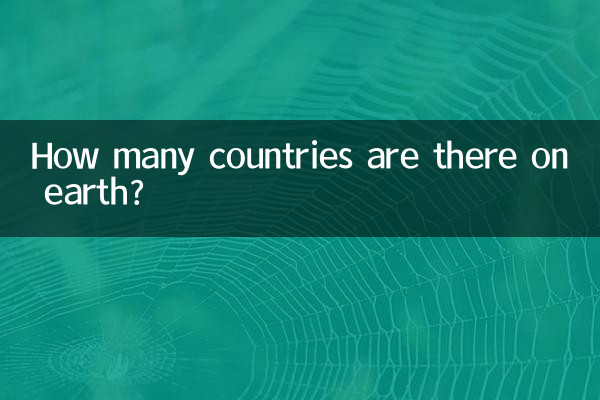How many countries are there on earth: analysis of the number of countries in the world and recent hot topics
In today's globalized world, knowing how many countries there are on the earth is not only a matter of geographical knowledge, but also closely related to international political, economic and cultural exchanges. This article will combine the latest data and hot topics in the past 10 days to present you a structured analysis report.
1. Statistics of the number of countries in the world

| Classification | quantity | illustrate |
|---|---|---|
| United Nations Member States | 193 | Including all internationally recognized sovereign states |
| observer state | 2 | Vatican and Palestine |
| Partially recognized countries | 6-10 | Including Kosovo, Taiwan, etc. |
| total | 195-206 | Varies according to different recognition standards |
2. Global hot topics in the past 10 days
| hot topics | Countries/regions involved | heat index |
|---|---|---|
| COP28 Climate Summit | 195 countries including the United Arab Emirates | ★★★★★ |
| OpenAI management changes | Many countries around the world | ★★★★☆ |
| Red Sea shipping crisis | Yemen, Israel, etc. | ★★★★☆ |
| Argentina's new president takes office | Argentina | ★★★☆☆ |
| Japan's Noto Peninsula Earthquake | Japan | ★★★☆☆ |
3. The political reality behind the number of countries
Although the United Nations currently has 193 member states, there are many disputes in the international community over the identification of national sovereignty. For example, Taiwan has complete government institutions and governance capabilities, but due to China's diplomatic pressure, it has only been officially recognized by 12 countries.
Another typical case is Kosovo. This country that declared independence in 2008 has been recognized by more than 100 United Nations member states, but major countries including Russia and China still refuse to recognize its sovereign status.
4. Recent developments in international relations
In the past 10 days, the COP28 climate summit, which attracted global attention, was held in Dubai, United Arab Emirates. Representatives from 195 countries gathered together to negotiate on global climate governance. This incident once again highlights the importance of international cooperation in addressing global challenges.
At the same time, the Red Sea shipping crisis has also triggered international concerns about regional security. Houthi armed forces' attacks on merchant ships caused many shipping companies to suspend Red Sea routes. This incident involved geopolitical games in many countries, including Yemen and Israel.
5. Trends in the number of countries
| period | Number of countries | Main changes |
|---|---|---|
| 1945 | 51 | Founding member states of the United Nations |
| 1990 | 159 | Number of countries since the end of the Cold War |
| 2011 | 193 | South Sudan becomes independent and becomes the newest member state |
Judging from historical trends, the number of countries around the world continues to grow. This mainly stems from major historical events such as the collapse of the colonial system and the disintegration of the Soviet Union. Experts predict that in the future, new countries may gain independence through peaceful or non-peaceful means.
6. National Identity in the Digital Era
In the era of the Internet and globalization, the definition and boundaries of countries are undergoing new changes. Emerging concepts such as cryptocurrency and the metaverse are challenging traditional concepts of territorial sovereignty. The recent management turmoil at OpenAI has triggered discussions on whether a transnational framework is needed for AI governance.
At the same time, social media allows cultural identities to transcend geographical boundaries. For example, during the recent presidential election in Argentina, its policy proposals sparked heated discussions in many Latin American countries, demonstrating the transnational influence of regional issues.
Conclusion
The number of countries on the earth is not only a statistic, but also a microcosm of the international political landscape. It can be seen from recent hot events that today, as globalization and localization go hand in hand, cooperation and competition between countries will continue to shape our world. Understanding these dynamics will help us better grasp the development trend of the international situation.

check the details

check the details